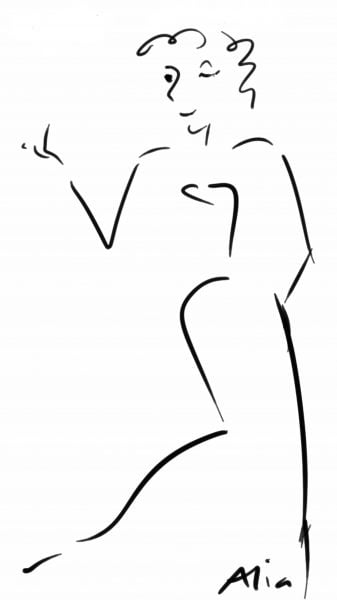(This was the Day 47 Love Note from 90 Days 2018)
I saw a Frank Zappa piece back in the 70s in which the musicians’ scores were comic books. Zappa conducted, and the musicians played the comic books (I think they had the same comic, but I can’t swear to it). The audience had a part as well—he gave hand signs for specific responses—we shouted sound effects like RUNCH! It was a wonderful concert.
It took those musicians a long time to get the chops to do that—not just to play their instruments—but to play a comic book. And it was the goofy intention to play a comic book that came first.

It has been suggested that one needs 10,000 hours of effort to master a skill.
Even the Sufis say one needs 1,001 days (or nights) of training. If you figure 10-hour days, there you have it. For many things, including dance, I am sure this is true. But it is also true that you can get a handle on something in as little as twenty hours. You won’t be a master, but you will begin to develop competence.
Twenty hours is what we get in my Community College classes. We have 15 weeks, and we dance for up to 1.5 hours each week (the rest goes to lecture and discussion). By the end of the semester, the students–who range from young gals who have taken part in their High School dance program to folks with nary a moment of dance experience—all somehow manage to miss the fact that they signed up for a dance class.
By the end of the semester, they have danced for a little over twenty hours—and they can dance. They can improvise. The whole class develops a group dance, and can solo briefly on their own—and look good doing it—happy and free. They each have their own unique style. In 20 hours.
We can do that, too. In the 90 Days, we dance 20 minutes a day for 90 days. It adds up.
Developing one’s own style is often portrayed as an enormous undertaking.
One must study like a dog for years, copy slavishly, and then, maybe, if the moon’s phase is just right, they may begin the arduous, perilous quest for their own style.
My opinion, if they hadn’t spent all the time slavishly copying, but instead worked on expression and allowing their body to discover its own response to the music (along with technique), they would have their own style, and long before anyone who spends their time executing other people’s choreography.
To have our own style, we have to practice it.
I know one of the things that makes people nervous about this practice is that they might start whiffing and snorting and stamping and shaking on stage.At which point the belly dance police will cart them off to prison.
People also wonder why we bother dancing to all the alternative music, since they want to be able to improv to belly dance music.
Improvisation is its own separate skill.
It can be applied to any genre.
And: often folks’ relationship with belly dance music is kind of stiff, hampered by the conditioning of copying and choreography, of Lego block dance, and fear of making mistakes.
So we use a lot of different music to break up that pattern. And we practice all this weird stuff like Slow Movement and Rhythmic Breath to help us respond to the music intuitively.
Bottom line, the music has a lot to do with what we do.
I know I dance differently to different music. I bet you do, too. But belly dance music inspires belly dance movement. And Turkish music brings out different movement from Egyptian music. And classic Tarab songs bring different music, and moods, the, for example, the Anghami Modern Dabke playlist. Make sense?
Moreover, the venue affects our dance as well. If I am dancing for myself, my eyes closed, I dance differently than when I perform for my guests. The focus of the show affects what I choose as well. Even the lights and the size of the stage affect what I do.
Then there are various intentions, which may show over the course of a song or a show—joyous here, nostalgic there, mysterious, whimsical, whatever. These all color the dance in different ways.
As we learn to respond in the moment, we organically develop our own style.
The beauty of all the improv practice, the beauty of learning to allow your body to respond to the music in the moment, is that all of this becomes easier the more we practice it. Because it is your body, your interpretation, it will perforce be unique and special.
Of course we need technique—we need it so we dance safely, have nice lines, and can execute our movement vocabulary. But improv dance is like slam poetry. You just let things come out of your mouth. You have to practice letting things come out as poetry, and that takes skill, but so does everything. Well. Most things worth doing well. Letting dance come out of your body takes skill, too. It’s all about TRUST.
So I invite you to cross train your improvisation.
Freewriting is good. I’ll talk more about that later.
I’m a largely improvisational cook—I’ll combine whatever I have with basmati rice and cook it for half an hour—voila, dinner.
I sing goofy little songs about what I am doing.
I’ve danced television shows for my practice time.
What do you do?
Where can you improvise?
What would be fun?
Love,
Alia
PS here is a Zappa concert from Brooklyn College in the early 70’s. I don’t think it’s the one I attended, but it’s a taste. I invite you to improvise to it. Be prepared for something unusual ; )
Is your weekly class on vacation for the summer?
Try ours! We’ll be having weekly FunClasses over the summer. These live classes are via Zoom. They last about an hour and include follow-me, features, and Dancemeditation. Sign ups open next week; classes start in June.






No comment yet, add your voice below!